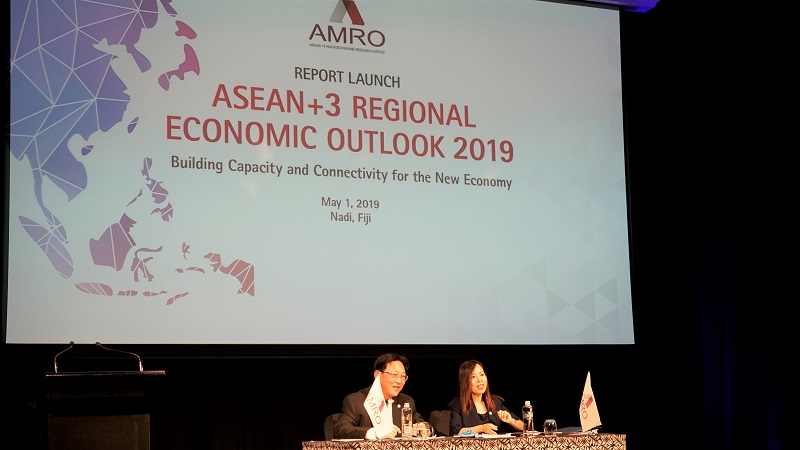The region should leverage on complementarities, embrace technology, and strengthen multilateralism and regional integration.
 AMRO Chief Economist Dr Hoe Ee Khor (left) delivers a presentation on key findings of the AREO 2019 at the report launch on May 1, 2019 in Fiji.
AMRO Chief Economist Dr Hoe Ee Khor (left) delivers a presentation on key findings of the AREO 2019 at the report launch on May 1, 2019 in Fiji.
Also available in Bahasa Indonesia | Chinese | Japanese | Khmer | Korean | Lao | Myanmar | Thai | Vietnamese
FIJI, May 1, 2019 – Despite heightened global risks and stronger external headwinds, the ASEAN+3 region is expected to remain resilient, growing at only a slightly slower pace in 2019–2020, compared to last year, says the new annual flagship report released today by the ASEAN+3 Macroeconomic Research Office (AMRO).
The ASEAN+3 Regional Economic Outlook (AREO) 2019 provides an assessment of the regional economic outlook and the risks and challenges facing the regional economies. In this year’s edition, the report also includes a thematic study titled “Building Connectivity and Capacity for the New Economy.”
“While regional growth is softening from 5.3% last year to 5.1% in 2019 and 5.0% in 2020, the longer-term economic fundamentals remain intact,” said AMRO Chief Economist Dr Hoe Ee Khor. “Regional policymakers should stand ready to use available policy space to ease monetary and fiscal policies to mitigate the downside risks and support the economy if external conditions were to worsen.”
The downside risks confronting the region are mainly external, stemming from an escalation in global trade tensions, a sharper slowdown in global growth, and volatility shocks from financial markets. Notwithstanding the softer outlook, the region’s long term fundamentals remain intact, supported by robust consumption and growing intra-regional trade amid a rising middle class, rapid urbanization, and adoption of digital technology.
However, as downside risks have become more pronounced, policymakers have little room for complacency. While current macrofinancial policy stances are generally appropriate, authorities in the region should be ready to recalibrate the policy mix to safeguard growth while preserving financial stability. These include some easing of monetary policy stance where appropriate; sustaining supportive fiscal policy, while combining targeted fiscal measures and structural policies to incentivize structural adjustments; and maintaining tight macroprudential policy to guard against the build-up of financial vulnerabilities.

About 70 participants attend the AREO 2019 launch.
To support the region’s growth prospects and foster resilience, ASEAN+3 should prioritize longer-term policies, especially those focused on building capacity and connectivity to leverage on the Fourth Industrial Revolution and sustain growth in the new economy. On this issue, the AREO 2019 contains a thematic study on how the region can do so, after more than two decades of prospering with the “manufacturing for exports” strategy.
Three key drivers will shape capacity and connectivity priorities in the region for the medium to long term. These are: new demands arising from the global transition to the Fourth Industrial Revolution or more broadly the new economy, East Asia’s maturing and increasingly affluent populations with an expanding middle class, and the tension between burgeoning intra-regional demand and headwinds from protectionist tendencies in the trade and technology space.
Against this backdrop, developing economies in the region continue to face three key challenges to growth: the funding, foreign exchange, and factors gaps. The funding gap captures the shortfalls between the low domestic savings and large investment needs of lower-income economies while the foreign exchange gap has to do with the financing constraint on emerging economies arising from the need to accumulate foreign reserves to mitigate risks related to sudden capital outflows. The factors gap captures non-financial constraints, including the need to develop human capital, expertise, technological capacity, and governance frameworks.
To address these challenges, there is a strong need for ASEAN+3 economies to leverage on intra-regional savings and investments; strengthen regional financial safety nets, including the Chiang Mai Initiative Multilateralisation (CMIM); and redouble efforts to develop ASEAN+3’s technological capacity, professional expertise in various fields, and further strengthen institutions for growth and governance.
“Rapid economic growth in the ASEAN+3 region will generate new infrastructure demand and sharpen the collective focus on meeting projected investment shortfalls,” says Dr Khor. “Transition to the technology-heavy and services-driven new economy could accentuate strains arising from conventional gaps facing the region, and it is imperative that the developing economies invest in human capital and leverage on the complementarities in the region. There is therefore a greater need than ever before for ASEAN+3 to embrace technology, integration, multilateralism, and further strengthening of regional financial safety nets.”

A reporter from Xinhua News poses a question to AMRO Chief Economist Dr Hoe Ee Khor.
—
About AMRO:
The ASEAN+3 Macroeconomic Research Office (AMRO) is an international organization, established to contribute to securing the economic and financial stability of the ASEAN+3 region, which includes 10 members of the Association of Southeast Asian Nations (ASEAN) and China; Hong Kong, China; Japan; and Korea. As an international organization, AMRO fulfils its mandate by conducting regional economic surveillance, supporting the implementation of the regional financial arrangements, the Chiang Mai Initiative Multilateralisation (CMIM), and providing technical assistance to its members.
